At The Beach, Water Contaminated By Fecal Coliform Less Worrisome Than Contaminated Sand

When “no swimming” signs appear at the seaside, a new study suggests there’s good reason why you should not only avoid the water but also the sand. More fecal contamination can be found on the sand than in the waves, the researchers say, due to different rates of bacterial deterioration.
“The differential decay of wastewater bacteria in beach sand and in seawater provides a kinetic explanation to the often-observed higher abundance of fecal indicator bacteria in beach sand,” wrote the authors.
What is fecal indicator bacteria?
The most common microbiological contaminants of natural waters are fecal coliform bacteria, which are considered indicator organisms, scientists at Clemson University explain in an online article. Indicator organisms signal the presence of other bacteria that may be pathogenic and harmful to your health. As the name suggests, fecal coliform are excreted in the feces of warm-blooded animals, including humans. Most are part of the normal digestive system, and only some are pathogenic, potentially causing ear infections, typhoid, dysentery, gastroenteritis, hepatitis A, and cholera.
Scientists use a quick-and-easy fecal coliform test to determine whether water has been contaminated with fecal matter. The Environmental Protection Agency sets acceptable limits for contamination based on how the water is used. Drinking water, for example, cannot contain any fecal coliform whatsoever, while swimming water may contain limited amounts.
Fecal bacteria, over the past decade, have been measured in sand at higher levels than in the nearby seawater — from 10 to 100 times higher. To understand why, Dr. Tao Yan, associate professor at the University of Hawaii, and his colleagues investigated the situation.
In the lab, Yan and his co-researchers created two separate microcosms, both contaminated with sewage, in an effort to gauge how the overall bacterial populations — including fecal contamination — would change over time. One microcosm consisted of beach sand, the other of seawater. Soon enough, they saw a possible explanation for why more fecal bacteria can be found on sandy beaches than in the waves.
The microbial communities tended to decay much slower in the simulated beach sand environment than in the water, Yan and his colleagues noted. Based on their microcosms, they suggest the bacterial populations in sand and seawater affected by wastewater pollution would decay in a similar fashion — fecal contamination would remain in the sand longer than the water.
Source: Zhang Q, He X, Yan T. Differential Decay of Wastewater Bacteria and Change of Microbial Communities in Beach Sand and Seawater Microcosms. Environ. Sci. Technol. 2015.
Published by Medicaldaily.com



























